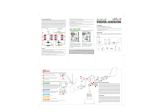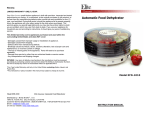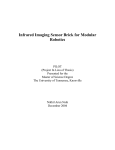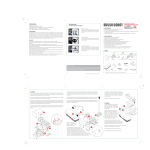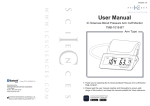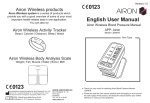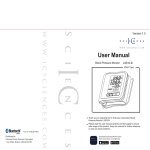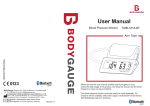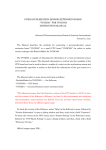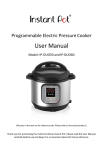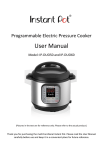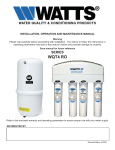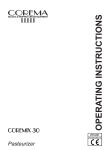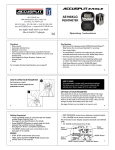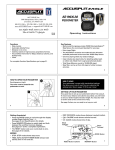Download English Instruction Manual
Transcript
Build a better tomorrow through education & awareness. You will like the other great Green Science kits: 00-03263 Dynamo Torch Turn a simple toy motor into a generator that converts hand motion into electrical energy and powers a light bulb. No battery, no pollution, just amazement. The generator could be used as an awesome emergency torch. Caution: High Voltage Inspiration & Fun! 00-03266 Soda Can Robug Millions of soda can are wasted everyday. Help save our environment. Recycle one of them and turn it into a cool robotic bug. Switch it on and watch it vibrate causing it to slide across the floor. It even emits a “buzz” as it moves along - just like a real bug. It’s an awesome robotic science kit. 00-03267 Windmill Generator Build this amazing wind generator and learn about renewable energy. Watch the LED glow as it is powered by free energy from the wind. No batteries required! To Parents: Please read through these instructions before giving gudiance to your children. A. SAFETY MESSAGES 1. Please read all instructions before you start. 2. Adult assistance and supervision is recommended at all times. 3. This kit is intended for children aged over 8. 4. This kit and its finished product contain small parts which may cause a choking hazard if misused. Not suitable for children under 3. 5. Do not use sewage water for the experiments. Sewage water contains bacteria and micro organisms which will contaminate the kits. Follow the instructions to mix artificial “dirty water”. This is sufficient to demonstrate the purifying effects of the kit. 6. This is only an experimental kit for demonstrating different methods of purifying water. The kit is not intended as a filtering device for drinking water. Do not drink the water purified with the kit. Some experiments involve hot water. Adult supervision is required. B. CONTENTS 4 filter sections 41-03281/1 090403 00-03279 Weather Station This ultra smart weather station has many functions. You can keep track of weather changes, learn facts about the weather and do experiments on the green house effect. When you have done exploring you can recycle a plastic bottle and make your very own mini green house. Small plastic cup Soft wax 3 bags of gravel Round filter base Transparent tube 2 metal washers Funnel-shaped collector Black plastic cup 2 transparent 4 filter plugs caps Fishing line 3 filter paper 3 bags of sand 3 bags of active carbon Silver reflector card Remarks: some materials from home are also required. Ask an adult before using these. 12 waterfilter_FL.indd 1-2 4/14/09 10:58:11 AM C. EXPERIMENT 1 - FILTERING Warning: The filter column is not intended as a filtering device for drinking water. Do not drink the filtered water. Gravels In this experiment, you use the assembled filter column from the kit to purify water. The various filters in the column remove impurities from the water. You will need: 4 x filter sections, 4 x filter plugs, filter base, soft wax, bag of active carbon, bag of sand, bag of gravel, filter paper. (Remarks: you need only one unit of those filters for setting up the filter column. Leave the other two as spare supplies for future experiments.) Sand Also needed from home (not included in kit): some soil from a clean source (e.g. pot plant or flower-bed), cooking oil, a glass (any size) and a glass (preferably transparent) whose diameter is smaller than the round filter base. Constructing the filter column Active carbon Filter paper 1. The filter plugs are specially designed for regulating the speed of water flow inside the column. There are six arches in the rim of each filter plug. Take two of the plugs and fill four arches in each one with a very small piece of wax, leaving two open arches. These two plugs will be used Soft Wax in the filter sections which contain sand and active carbon. They will reduce the X2 X2 speed of flow through the sections, allowing the sand and active carbon to achieve their best filtering effect. 2. Fit the filter plugs into the holes in the bottom of each filter section. You may need to push the plugs into place with a pen. You should have two sections with plugs with six open arches and two sections with plugs with two open arches. 3. Clean the gravel, sand and active carbon separately before filling in the filter sections. Simply place each of the materials in a small container (don’t mix the materials). Rinse them with clean water a few times. This will remove any dust sticking to them. 4. Put the sand and active carbon into the filter sections with filter plugs of two open arches, and the filter paper and gravel into the sections with filter plugs of six open arches. 5. Put the filter base on a table. Put the filter sections onto the base in the following order from the bottom: filter paper, active carbon, sand, and finally gravel. Make sure each section snaps into place on the one underneath. 6. Stand the completed filter column on top of the glass. Preparing the artificial “dirty water” Half fill a small glass of water. Add the soil and oil to it and stir to make a brownish coloured mixture. This will be the “dirty water” for the filtering experiment. (Always wash your hands after handling soil or the dirty water.) Oil Mud Artificial “dirty water” Gravels Sand Active carbon Filter paper Doing the experiment Pour some artificial “dirty water” mixture into the top of the filter column VERY SLOWLY. The water will trickle slowly down through the filters. For the best results, the water should be moving between the filter sections drop by drop. How clean is the water that runs into the glass? 2 waterfilter_FL.indd 3-4 3 4/14/09 10:58:15 AM How it works Each section of the filter column removes particles from the water, purifying it. The different filters remove particles of different sizes. The grains of sand and gravel have small spaces between them. These allow water to pass through, but trap particles in the water. The carbon granules are made from a material called active carbon. Chemicals in the water cling to the surface of the carbon and are removed from the water. This process is called adsorption. The filter paper has tiny holes between its fibres. Water can trickle through the holes, but particles larger than the holes are trapped. It is particularly effective in filtering oil. The filter column demonstrates the principles used at water purification plants, which supply drinking water to households. At a water purification plant the filtering process is more advanced and chemicals are added to the water to ensure the water is safe for drinking. Cleaning the filter material and filter column Always clean the filtering materials and the filter sections when you finish with them, or when you want to filter a new mixture. The sand, gravel and active carbon can all be cleaned and reused. Simply place each material into small glass (don’t mix the materials). Fill the glass with clean water, add a drop of detergent and stir gently. Let the material settle to the bottom and then carefully pour away the water. Then rinse the material once or twice with clean water. Also rinse out the filter sections with clean water. When the materials are clean, pour them back into their filter sections (remember to put the sand and active carbon into the sections with two open arches in their plugs). When your filter materials have been used a few times, you may need to replace them with the spare supplies included in this kit. When you run out of the spares, you can buy more in most aquarium shops. Fine sand from a beach and gravels from a garden could also be used, but rinse them thoroughly before use. You could use tissue paper instead of filter paper. Where we use filters • Filters have a huge range of uses at home and in industry. At home we use filter paper for filtering coffee grains from coffee, and active carbon granules for filtering water, where they remove chlorine and other chemicals from tap water. Filter paper and active carbon are used in machines to clean water, fuel, oil and air before they are needed, and in gas masks to remove dust and dangerous gases from air. • Sand filters are used mainly for cleaning water before and after we drink it. The type of sand filter in this kit is called a fast sand filter, as water trickles quickly through it. It removes solid particles, such as grit, from water. Slow sand filters are deep layers of fine sand. As water trickles through a slow sand filter, a layer of micro-organisms forms slime on the top. These organisms use particles in the water as food, so cleaning the water. Fun facts • Sand filters clean the water in fish tanks and swimming pools, and water from sinks and baths (called grey water) so that it can be used to water gardens. • Active carbon is very porous - water flows easily through the granules because they are full of holes. • A one-gram piece of active carbon has a surface area of about 500 square metres - the same as a basketball court. • Active carbon is sometimes fed to people who have been poisoned because it traps the poison in their stomachs. • Filter paper is used in paper chromatography, which is a way of separating materials dissolved in a liquid. Trouble shooting If you find the filtered water not clear or clean: • Try re-filtering the water. The filter column is only small and may not clean the water completely in one pass through, especially if your water is particularly “dirty” or “oily”. • Check that the water is not running through the filter sections too quickly. If it is, try pressing the filter sections together more tightly, and even sealing around the joins with sticky tape. This will prevent air leaking into the filter sections, allowing the water to flow downwards slower. • Make sure you have put the sand and active carbon into the filter sections that contains the plugs with two open arches. The “dirty water” needs to flow slower in these two sections. • You may need to clean or replace the filter materials with the spare supplies included in this kit (see above). 4 waterfilter_FL.indd 5-6 5 4/14/09 10:58:15 AM D. EXPERIMENT 2 - DISTILLATION Warning: This experiment requires hot water. Adult assistance and supervision is required when handling hot water. In this experiment you purify water by a process called distillation. The water evaporates, leaving the impurities behind. Distillation is another common method of producing clean water. The method is commonly used in desalination plants. You will need: funnel-shaped collector, small plastic cup. Also needed (but not included in the kit): a glass of hot water (hot enough to be steaming), ice cubes, and some tea leaves. Doing the experiment 1. Ask an adult to help you with this step. Prepare a glass steaming of hot water. Mix it with the tea leaves. 2. Push the base of the collector into the cylinder in the centre of the cup. Place the collector on top of the glass containing the tea. 3. Drop some ice cubes into the collector. 4. After a while, look at the underside of the collector. You should soon see condensation. Eventually drops of clear water will run down and drop into the cup. Ice cubes Condensation Tea leaves Hot tea Hot water Trouble shooting If only a little clear water is collected, check that the water is hot enough. Only hot water with steam rising from it will generate enough vapour to demonstrate distillation. Empty the water in the set up and redo the experiment with hot water. Where we use distillation Distillation is used to clean drinking water and for making sterile water for medical use and for cleaning contact lenses. It is also used in desalination plants, where fresh water for drinking is made from sea water. In chemistry, distillation is used to remove water from a liquid without losing the water. And in the oil industry, distillation is used to separate crude oil into different products, such as butane gas, petroleum and fuel oil. In those distillation plants, the liquid to be distilled will be heated to generate the vapour for completing the process. Demonstrating the water cycle You can use the same equipment to investigate the Earth’s water cycle. For this you will also need a tall transparent glass whose diameter is smaller than the collector (or ask an adult to cut the top third off a small plastic bottle), some soil and a small plant, such as an ivy. 1. Put a few centimetres of soil into the base of the glass. Make a hole in the soil, gently push in your plant and press the soil around its roots. Pour a little water into the soil. 2. Put the collector and cup over the glass. (If you are using a bottle base, make sure the rim of the bottle fits closely under the collector, otherwise water vapour will escape through the gap. You may need to seal the gap with sticky tape.) 3. Put the cup in a sunny place and wait a few hours. Look at the underside of the collector. You should see condensation, and water should eventually run into the small cup. Condensation Clear Water This experiment is a model of the water cycle. Water evaporates from the soil and the plant, as it does in nature, because of heat from the Sun. The condensation on the collector represents the formation of clouds, and the dripping water represents rain. Clear Water Fun facts 1 2 3 4 How it works Water evaporates from the surface of the hot tea. This means the liquid water turns to water vapour (the gas form of water). However, neither the tea leaves nor the chemicals they release into the water evaporate. The ice makes the collector cold. When the water vapour hits the collector, it cools and condenses (turns back to liquid water). Then it drips into the cup. So the process of evaporation and then condensation, which is known as distillation, removes impurities (the tea leaves and chemicals in this experiment) from the water. 6 waterfilter_FL.indd 7-8 • The distillation equipment in this kit is known as a “still”. • A solar still is powered by the Sun and used to purify water in hot countries. The Sun’s heat makes the water evaporate, and cool air makes it condense again. • The water cycle is the constant circulation of water between the oceans, the atmosphere and the land. It makes clouds and rain form, and rivers flow. 7 4/14/09 10:58:18 AM E. EXPERIMENT 3 - SOLAR PASTURIZATION Warning: The solar-heated water could reach a temperature of 60 degrees Celsius (149 degrees Fahrenheit) or more. Handle the heated water with care. Adult supervision is required. In this experiment you purify water by a process called solar pasteurization. When water is heated to 65 degrees Celsius (149 degrees Fahrenheit), dangerous micro-organisms in the water are killed. Heat from the Sun is used to heat the water to pasteurize it. The experiment involves the use of a simple device called a water pasteurization indicator (WAPI) to determine if the water has been heated to the required temperature. You will need: black plastic cup, silver card, the parts for making a Water Pasteurization Indicator (WAPI), i.e. metal washers, fishing line, transparent tube, transparent caps and wax. Also needed from home (but not included in kit): a tall glass that will cover the whole of the black plastic cup. A small piece of transparent plastic sheet (e.g. kitchen food wrap). Assembling the water pasteurization indicator (WAPI) You need to assemble the WAPI before the experiment: 1. Push the wax into one end of the transparent tube. 2. Push the transparent caps into the tube. 3. Tie a washer to one end of the fishing line. 4. Feed the other end of the line through the hole in one transparent cap and then through the other transparent cap. 5. Pull some spare line through and tie a washer to the end. 3 5 4 4 1 2 2 Doing the experiment 1. Join the two pieces of card together by gently pushing the tabs in the large piece into the slots in the smaller piece. Pull the sides together Transparent to make a three-sided shape and fix with plastics sheet sticky tape if necessary. 2. Stand the silver box on the ground in hot sunshine so that the Sun’s rays shine into the corner. Place a small piece of transparent plastics sheet in the bottom (to prevent the condensed water drops damaging the cardboard). Put the black plastic cup in the corner, on the plastic sheet. 3. Fill the cup with water 4. Examine the indicator. Pull the fishing line through the holes until one washer is next to the end cap at the opposite end of the tube to the wax. This end will be the bottom end of the indicator. 5. Put the indicator into the water, making sure that the wax is at the top of the tube. Hang the spare fishing line over the edge of the cup. 6. Cover the whole cup with the transparent glass. The water will now start to be warmed by the Sun’s heat. (You could put a weight (e.g. a stone) on top of the inverted glass so that its rim is pressed firmly onto the plastic. This will prevent heat leaking away.) 7. Every half hour lift out the indicator and check the state of the wax. When the wax has melted and run to the bottom of the tube, the water is hot enough and has been pasteurized. You should be able to pasteurize the cup of water in around two hours on a sunny day. You might also see condensation inside the glass. The plastic sheet will prevent the condensed water from damaging the silver reflector cardboard. Note: to use the WAPI again, simply slide the transparent tube to the other end of the fishing line. 65°C Condensation Soft Wax 8 waterfilter_FL.indd 9-10 9 4/14/09 10:58:21 AM How solar pasteurization works The reflectors are angled to converge and concentrate solar energy. The black plastic cup absorbs the energy, which heat up the water inside. The space in between the glass and cup works like double-glazing. The trapped layer of air inside insulates the cup, preventing too much heat loss. When water is heated to 65 degrees Celsius (149 degrees Fahrenheit) all the dangerous microorganisms in it are killed. Heating water to this temperature is called pasteurization. The wax in the indicator melts at a few degrees higher than this. When it melts, it runs down the tube. So when the wax moves down the tube, you know that the temperature for pasteurization has been exceeded. Where we use pasteurization The experiment demonstrates an economical and effective way of pasteurizing water in remote areas where there is no mains water (water supplied through pipes) and no electricity to heat it. Here, pasteurization is used to make water from wells and rivers safe to drink. Using solar energy to heat up the water is cheap and convenient. An indicator such as the one in this kit shows when the process is complete. Pasteurization is also important in the food industry. It is used to treat milk, fruit juices and many other foods. It kills any micro-organisms in the foods and helps to keep them fresh for longer. Trouble shooting If the water does not heat up to desired temperature (where the wax in WAPI melts and falls to the bottom): • The sunshine may not be strong enough. Try again on a sunny day, around midday, when the Sun is at its highest and its rays are strongest. Avoid doing the experiment in a windy day. • Keep checking that the collector is facing the Sun (remember that the Sun moves across the sky as the day passes). • Check the glass is touching the plastic sheet all round. If not, add a weight (see step 6 above). If you do not get a lot of strong sunshine where you live (or it is winter), or you need to demonstrate the experiment at a science fair, you could use a desk lamp with a 60-watt incandescent bulb (not a fluorescent energy-saving bulb) to act as he Sun. Shine it at the reflector from close by. You should be able to achieve the pasteurization temperature, but it will take longer than in sunlight, which is much stronger. Warning: Adult supervision is required when using a desk lamp. Fun Facts • The pasteurization process was invented by and named after the French chemist Louis Pasteur. • Pasteurization kills micro-organisms found in water that are harmful to people, including guardia, cholera, salmonella, E. Coli and rotavirus. • Pasteurization is not the same as sterilization, which kills all micro-organisms. Water can only be sterilized by boiling it. 10 waterfilter_FL.indd 11-12 F. THE FUN IS UNLIMITED - FURTHER EXPERIMENTS Warning: Adult assistance and supervision is required. Use the kit to do further experiments. 1. Separate the filter sections. Do the filtering with only one type of filter used. Compare the results and you will see the different functions of different filter materials. 2. With an adult’s permission and assistance, mix different liquids or materials from your kitchen (such as coffee, soft drinks and cornflakes) to create different sorts of “dirty water”. Remember that your filter column is only small and may not be able to clean some liquids completely. However, it will demonstrate the principle of filtering. Also note that your filter column will not remove materials dissolved in the water. For example, the dissolved sugar in a soft drink will remain in the filtered liquid, even if the liquid looks clear. Clean the filter column and the filters after completing each experiment as any organic materials left inside the filters may decompose and become smelly. 3. Using the set-up in experiment 2, make a solar still. Put some salty water in the glass. You don’t need ice cubes. Place the equipment on the silver reflector from experiment 3 and leave it in the midday sun. You should collect some pure, unsalted water. Can you explain how this solar still works? 4. In experiment 3, use a white plastic cup instead of the black one, or take away the glass cover, or remove the silver reflector card. Can you still achieve the pasteurizing temperature i.e 65 degrees Celsius (149 degrees Fahrenheit)? And why? G. ALARMING WATER FACTS • About fifth of world’s population does not have access to clean drinking water. • Three-quarters of all illnesses and deaths in the developing world are caused by diseases carried in water, such as cholera. • Two million children die each year from drinking dirty water. Help save the environment by preserving our clean water resources. QUESTIONS & COMMENTS We treasure you as a customer and your satisfaction with this product is important to us. In case you have any comments or questions, or you find any parts of this kit missing or defective, please do not hesitate to contact our distributor in your country, whose address is printed on the package. You are also welcome to contact our marketing support team at Email: [email protected], Fax (852) 25911566, Tel (852) 28936241, Web site: WWW.4M-IND.COM 11 4/14/09 10:58:23 AM






